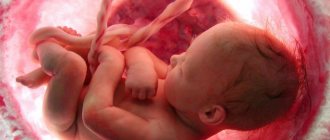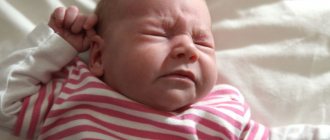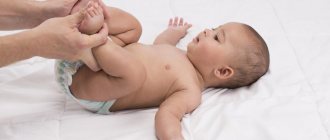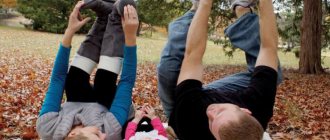By days
1st day.
The sperm connects with the egg. As a result, one “large” (smaller than a grain of salt) cell is formed, which contains 46 chromosomes inherited from the parents (23 chromosomes from each). A fertilized egg carries all the genetic information about the future person: his gender, eye, skin and hair color, facial features. 3-9 . The fertilized egg descends through the fallopian tube into the uterus. The embryo attaches to its wall and soon begins to receive the necessary substances for nutrition and oxygen for breathing with maternal blood, which reaches it through the umbilical cord and the branched chorion (the future placenta).
10-14th days. The embryo increases by one tenth compared to its previous size.
20th day. The process of establishing the nervous system begins.
Day 21 The heart begins to beat.
Day 28 The spine and muscles are formed. An ultrasound shows arms, legs, eyes, ears.
Day 30 Over the past month, the embryo has grown 10 thousand times and continues to actively develop. The heart pumps an ever-increasing amount of blood through the circulatory system.
Day 35 You can see the fingers on the baby's hand. The eyes darken because the child’s body has already begun to produce pigment.
40th day. Using a special device, it can detect and record signals coming from the brain.
First trimester
6 weeks. The liver begins to produce blood cells, and the brain controls muscle movement and heart function.
7 weeks. The eyelids begin to cover the baby's eyes, protecting them from light and dryness (from the 28th week the baby will be able to open and close his eyes at will). At the same stage of pregnancy, the baby’s inner ear is formed, the outer ear develops, the jaws are formed, and the rudiments of teeth appear. But the most important thing is that the baby begins to move. However, the mother does not feel this because the child is still too small.
8 weeks. The baby has grown to 2.5 centimeters. He already looks like an adult. The heart beats, the stomach produces gastric juice, and the kidneys function. Muscles contract under the influence of impulses coming from the brain. Based on the child's blood, you can determine his Rh status. Fingers and joints have formed. The baby’s face acquires certain features and facial expressions develop. The baby's body responds to touch.
10 weeks. The child's height reaches 4 centimeters, weight - approximately 2 grams. During this period, the baby’s external and internal genitalia begin to form.
12 weeks. The baby is growing. From time to time he sucks his thumb. During the waking period, the child vigorously trains his muscles: he turns his head, bends his fingers and toes, opens and closes his mouth. The baby already hears and sees: if sharp sounds coming from the outside world begin to disturb him, he tries to cover his ears with his hands, and tries to block the beam of light directed into his eyes with his palm. If you touch his palm, it will clench into a fist. All these movements are carried out due to the fact that the baby has formed a vestibular apparatus, which helps him navigate in space.
Baby, how are you?
Studies have shown that in utero a child reacts to external sounds and brightness of light. Their strength affects the intensity of his movements. It is also known that its activity is influenced by both the mental and physical state of the mother. The state of wakefulness and rest can change in the fetus within every hour. This occurs in accordance with the physiological rhythms of its intrauterine development, which are different for everyone. Some babies may be more mobile in their mother's belly, while others may be calmer. Their intrauterine life follows its own laws, which have not yet been fully studied.
Even in the mother's womb, children have days of special activity and periods when they want to rest and behave calmly. Sometimes fetal movements can be caused by the body touching the inner wall of the fetal membrane, from which it moves away. Perhaps not enough oxygen is supplied to him through the blood through the umbilical cord. When it moves, its position changes, blood flow increases and oxygen supply increases.
The fetus makes breathing movements, sighs, and sometimes hiccups. At times, the expectant mother feels cramps in her stomach from his hiccups. In the fetus, as in the newborn child, this does not cause any particular inconvenience. With some babies this happens every day, or even several times a day, while others do not hiccup at all.
The number of fetal movements increases as pregnancy progresses. Rhythmic beats in some cases become regular and are repeated at constant intervals, while in others the fetus pushes spontaneously and variedly. The greater activity of the fetus in the mother's womb does not mean at all that after birth it will be more restless than those babies whose movements were less intense.
D. Pearson's test "Count to ten"
On a special card, the number of fetal movements is recorded daily from 28 weeks. Counting starts at 9:00 and ends at 21:00. A small number of movements (less than 10 per day) may indicate oxygen deficiency in the fetus and is a reason to consult a doctor.
Second trimester
16 weeks. The child weighs approximately 150 grams, his height reaches 16-18 centimeters. Hair appears on the head, eyelashes and eyebrows appear on the face. The baby opens his mouth, swallows, sucks, smiles. During this period, the placenta begins to fully function, which connects him with his mother.
20 weeks. The baby's height reaches 30 centimeters, and marigolds appear on his fingers and toes. Now my mother feels his movements, as from time to time he begins to engage in physical activity: he pushes off from one wall of the uterus and swims to the other. In addition, the child may react to a sharp sound or the mother's excitement by jumping, which is perceived as an active movement. If the baby begins to hiccup, the woman feels weak rhythmic tremors coming from inside. At 20 weeks, doctors listen to the baby's heartbeat using a stethoscope.
24 weeks. The baby may already be angry. This is proven by a photograph of a child at this age. It shows his angry look, the tension of the muscles around his eyes, his wrinkled lips, and it is clear that he is crying, expressing his dissatisfaction. By the way, in order to rest at night, the baby goes to bed and... dreams. The child weighs about 500 grams, which is not much, but he has just begun to gain weight. His skin is red and wrinkled. Since she is still very tender, the baby is protected from the effects of amniotic fluid with a special lubricant. By the 24th week of pregnancy, fat and sweat glands begin to function, and the baby’s lungs mature. A film forms in them, which prevents them from sticking together when breathing. If the child is born at this time and is provided with the necessary care, he will be able to survive.
Can a fetus feel touch and pain?
The fetal nervous system develops very quickly - by the 7th week it has receptors around the mouth, by 12 - all over the face, feet and palms, and by 28-30 the nerve endings are fully mature and the receptors cover the entire body. The baby, who develops in the womb for only 2 months, develops a reaction to irritants, so he is able to feel pain. From 15–20 weeks, the baby already feels touches on the belly of his mother or father. The gradually developing sense of touch allows him to feel pressure from the outside with the entire surface of the body at the moments of its contact with the walls of the uterus.
Touching the fetus's body causes a reaction - it responds to the parents' gestures with pushes. That is why it is important to stroke your belly, showing affection and care for your baby. The sensations of a child developing in the womb become more orderly and “understandable” to him during the 2nd trimester. This is confirmed by children who were born prematurely - they respond well to tactile contact.
The child feels pain and reacts to physical injuries starting from the 2nd month of development. A blow to the mother's stomach frightens the baby, he tries to shrink and hide, moving as far away from the threat as possible.
Third trimester
28 weeks. The child weighs about 1000 grams, his height reaches 35 centimeters. He has already developed all his senses - these data are confirmed by a study of brain biocurrents (EEG) of an unborn child. He begins to recognize his mother's voice. The baby performs the first elementary breathing movements. His skin thickens (thickens) and becomes more like a newborn's skin. If labor begins at this stage of pregnancy, it will be called premature, but doctors will be able to help the baby survive.
32 weeks. The child weighs about 2000 grams, subcutaneous fatty tissue forms, and his arms and legs become plump. The formation of the immune system occurs: the baby begins to receive immunoglobulins from the mother, which will protect him from diseases in the first months of life. The volume of amniotic fluid surrounding the baby is one liter. Every three hours they are completely renewed, so the baby always swims in “clean” water, which can be swallowed painlessly.
34 weeks. The baby weighs 1800-2100 grams, his height reaches 40-41 centimeters. He becomes cramped in the uterus: he can no longer turn over and most often lies head down. His lungs are finally maturing, and in the event of premature birth, the baby will breathe on his own. However, the subcutaneous fat layer is still poorly developed and does not retain heat well.
36-38 weeks From the ninth month of pregnancy, the baby gains weight daily (up to 14 grams). Iron accumulates in his liver, which will help hematopoiesis in the first year of life. The fluff that covers the baby's skin (especially the shoulders and back) disappears by the time of delivery. The child is growing rapidly, the uterus becomes too tight, so his movements are felt more intensely.
Usually at 38 weeks its head descends to the entrance to the pelvis. The baby is ready for independent life and is counting the days until birth...
How does a child feel when mom cries?
You can “upset” a child even in the womb. He begins to understand what is happening from 3-4 months of gestation, and from 29 weeks the baby has already developed all the senses. The child copies the actions of the mother, so the woman must control her emotional state.
When a woman cries, her body produces cortisol, a stress hormone, which is transmitted through the bloodstream to the baby, so he becomes sad along with her. The child reacts very sharply to the mother’s mood swings, but some circumstances do not depend on the pregnant woman - a woman can get upset and cry because of some little thing under the influence of changing hormonal levels.
Sources
- Kadan G., Aral N. Effects of Mycotoxins on Child Development. // Curr Mol Pharmacol - 2021 - Vol - NNULL - p.; PMID:33319679
- Stoye DQ., Blesa M., Sullivan G., Galdi P., Lamb GJ., Black GS., Quigley AJ., Thrippleton MJ., Bastin ME., Reynolds RM., Boardman JP. Maternal cortisol is associated with neonatal amygdala microstructure and connectivity in a sexually dimorphic manner. // Elife - 2021 - Vol9 - NNULL - p.; PMID:33228850
- Kendal E. Unique benefits of ectogenesis outweigh potential harms. // Emerg Top Life Sci - 2021 - Vol3 - N6 - p.719-722; PMID:32915221
- Kpewou DE., Poirot E., Berger J., Som SV., Laillou A., Belayneh SN., Wieringa FT. Maternal mid-upper arm circumference during pregnancy and linear growth among Cambodian infants during the first months of life. // Matern Child Nutr - 2021 - Vol16 Suppl 2 - NNULL - p.e12951; PMID:32835455
- Lautarescu A., Craig MC., Glover V. Prenatal stress: Effects on fetal and child brain development. // Int Rev Neurobiol - 2021 - Vol150 - NNULL - p.17-40; PMID:32204831
- Apostol AC., Jensen KDC., Beaudin AE. Training the Fetal Immune System Through Maternal Inflammation-A Layered Hygiene Hypothesis. // Front Immunol - 2021 - Vol11 - NNULL - p.123; PMID:32117273
- Paglia L. Taste development and prenatal prevention. // Eur J Paediatr Dent - 2021 - Vol20 - N4 - p.257; PMID:31850766
- de Souza RJ., Zulyniak MA., Stearns JC., Wahi G., Teo K., Gupta M., Sears MR., Subbarao P., Anand SS. The influence of maternal and infant nutrition on cardiometabolic traits: novel findings and future research directions from four Canadian birth cohort studies. // Proc Nutr Soc - 2021 - Vol78 - N3 - p.351-361; PMID:31140389
- Altimier L., Phillips R. Neuroprotective Care of Extremely Preterm Infants in the First 72 Hours After Birth. // Crit Care Nurs Clin North Am - 2021 - Vol30 - N4 - p.563-583; PMID:30447814









